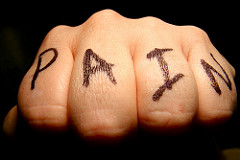September is Arthritis Awareness month in Canada. It’s also a subject dear to my heart, as my mom and aunt had rheumatoid and I have 4 osteo-arthritic discs in my back due to a fall when I was younger. For more information on arthritis, go to The Arthritis Society.
By Paula Spencer Scott, Caring.com Author
Think arthritis is just for the old? Half of those who get it are under age 65. One in five adults — 50 million Americans — has been diagnosed with arthritis. Most wait to see a doctor until pain interferes with daily life — but pain isn’t the only sign of trouble.
“Early is better with arthritis diagnosis,” says Arthritis Foundation Vice President Patience White, a professor of medicine and pediatrics at the George Washington University School of Medicine and Health Sciences in Washington, D.C. Treating the autoimmune disease rheumatoid arthritis (RA) within the first months of onset, for example, can minimize joint deformities and even put the disease into remission, thanks to the latest treatments. With osteoarthritis (OA), a degenerative joint disease that’s the most common kind of arthritis, the sooner you start behavioral changes, the better you may be able to manage pain and preserve mobility, White says.
Here’s what to watch for:
Warning sign #1: Morning stiffness
Look for: Waking up and being unable to move about easily for half an hour or longer. Everybody has some morning stiffness, but normally it fades as you stretch and start moving. “With rheumatoid arthritis, it can take 30 minutes or more to loosen up — sometimes hours, or even all day,” says Chaim Putterman, chief of rheumatology at the Albert Einstein College of Medicine and Montefiore Medical Center in New York City. “People affected say they feel encased, like prisoners, and the feeing of being unable to move can be even more burdensome than the actual pain.”
Why pay attention: Stiffness after inactivity is a hallmark symptom of rheumatoid arthritis. It can recur later in the day when you’ve been sitting still for awhile — after watching a movie, for example. With osteoarthritis, the more you use your affected joints, the worse they tend to feel; with rheumatoid arthritis, the more you move, the better it feels, Putterman says.
Warning sign #2: Pain when climbing stairs
Look for: Your knee joint locking or sending stabs of pain when you bend it, as when going up or down stairs. Added red flag: Knee pain if you’re overweight. “Every extra pound you gain feels like an extra load of four pounds on your knees,” White says. Excess weight raises your risk of developing arthritis, which some 60 percent of obese people develop.
Related types of painful physical function include limping, being unable to extend your elbow, changes in how steadily you can stand or walk, and trouble standing on tiptoe.
Why pay attention: The knee is the largest joint in the body and the second-most common site for osteoarthritis, according to White. (A bow-legged “cowboy” walk can result from osteoarthritic knees.) Other key targets: the hips, the back, the ankles, the thumbs, and the hands. “People really don’t go to the doctor until they can’t do what they want to do — lift a baby, walk a block, get out of bed easily — and pain is the number-one reason why,” White says.
Caregivers should beware of a debilitating cycle in loved ones with arthritis, Putterman says. If activity is painful, you avoid it, you stay inside more, you sit home and eat, you gain weight, which makes you even less able to get out — and before you know it, you’re on a path to losing independence.
Warning sign #3: Sudden, excruciating pain in a big toe
Look for: A joint that suddenly hurts like crazy — many sufferers give it a “ten” on a pain scale of one to ten, likening the pain to kidney stones, White says. The joint is likely also red, hot to the touch, and tender. Although this pattern can happen to other joints, the big toe is the most common site. Usually only one joint is affected at a time.
While the vast majority of cases have a sudden onset, some people notice a joint becoming hot, red, and tender, but the pain is bearable. It clears, then recurs.
Some people can connect the onset of pain to eating a lot of protein or drinking more alcohol than usual.
Why pay attention: Sudden, excruciating pain, especially in the large toe, is likely an attack of gout, the second-most common form of arthritis and the most common type of inflammatory arthritis. Gout occurs when uric acid, a natural waste product that circulates in the blood, builds up in body tissue as needle-shaped crystals. This happens either because the body produces too much uric acid or doesn’t dispose of it well through the urine.
Men in their 40s and 50s are affected most by gout, though by the 60s, it affects both genders equally. Left unmanaged, attacks of gout can strike more often.
Warning sign #4: Fatigue, flu-like symptoms
Look for: Chronic tiredness, loss of appetite, weight loss, anemia, and/or fever that persists for weeks (longer than a bout of flu). Some combination of these symptoms usually appears, along with stiffness and pain. You might even notice changes in nonjoint tissue, such as eyes that feel dry and sore and may be red. These symptoms can come on gradually or suddenly.
Why pay attention: Having these mild, flu-like, across-the-body symptoms, along with stiffness and pain, points to rheumatoid arthritis. RA is a disorder of systemic inflammation, meaning the entire body is affected (as opposed to the problem being isolated in a particular joint). “You shouldn’t just take two Tylenol and sleep the discomfort off,” Putterman says. These symptoms warrant a physical exam soon.
Warning sign #5: Odd-looking bumps on fingers
Look for: Bony spurs (small enlargements) on the joint of fingers. One may appear on the last joint, where it’s known as a Heberden’s node, or on the middle joint, where it’s called a Bouchard’s node. Sometimes the knobby bump appears at the base of the thumb (though this bump wasn’t named after the doctor who studied it).
The joint is probably also stiff to move, although not necessarily painful. To the touch, the bump feels more like a bone than like a sponge. Some toes can also be affected.
Why pay attention: Doctors use this visual information to help diagnose arthritis, along with the rest of a physical exam, a history, and, sometimes, X-rays and lab tests. Heberden’s nodes and Bouchard’s nodes, seen in osteoarthritis, tend to run in families, especially through women, White says. Farmers and others who engage in a lot of manual labor are especially prone to OA of the lower extremities.
Warning sign #6: Pain that interferes with sleep or pleasure
Look for: Being unable to fall asleep because you’re so focused on joint pain, or being awakened in the middle of the night by joint pain. Some sufferers begin to avoid family and other activities they enjoy because they feel ground down by chronic pain; the very prospect of visiting grandchildren or going to a social outing feels overwhelming.
Why pay attention: Osteoarthritis pain is caused by eroding cartilage, which eventually causes bone to rub against bone — and yes, it can really hurt. Everyone has a different threshold for pain. But pain that interferes with your ability to enjoy the most basic, restful activities of life like sleep or enjoying your family? That’s a different animal. “It shows that what you’ve been doing before is not adequate and that the pain should be taken care of,” Putterman says.
What’s more, when chronic pain saps your joie de vivre, depression can evolve.
Warning sign #7: Achy, hard-to-use hands
Look for: Trouble managing fine-motor skills: buttoning a shirt, tying shoelaces, using a fork and knife, turning a key in a lock, grasping a doorknob, snapping fingers.
Affected joints can be redder than surrounding skin, warm to the touch, and tender.
Why pay attention: “Trouble with these activities of daily living all suggest something worrisome is going on,” Putterman says. Many different joints in the hands and wrists tend to be involved with rheumatoid arthritis, making these hand and finger tasks so frustrating. Rheumatoid arthritis is also a symmetrical disease, meaning both sides of the body (and hands as well as feet) tend to be affected simultaneously. (In osteoarthritis, the joints affected usually aren’t symmetrical.)
Notice which part of the hand is affected. Rheumatoid arthritis tends to afflict the knuckles and the next joint up, White says. In osteoarthritis, the top joints and the base of the thumb are more affected, and not necessarily all of the digits at once.




Normal steroid cycles are often the starting point for model spanking new users however are also a staple within the
strategy of experienced bodybuilders. The outcomes achieved over a
10–12-week standard cycle can be fantastic (provided you
work onerous within the gym). It’s also not an overwhelming size of time
to commit to using steroids. PCT is used to hurry up the
restoration of your pure testosterone production after it’s been suppressed or even totally shut down if you use anabolic steroids.
A number of steroid customers counsel that the media is warping the concept of steroids and their long-term effects.
Some regard using the drugs as a approach to ‘cheat’ the
system as steroids are capable of present noticeable
fast results. While steroids can provide speedy muscle features,
the potential dangers and unwanted effects have to be rigorously weighed.
A balanced method that includes correct coaching, nutrition, and consideration of options can lead to
sustainable and wholesome muscle growth without the necessity for steroids.
All The Time consult with a healthcare skilled earlier than embarking on any steroid use or important
adjustments to your health routine.
Users’ genetic makeup will decide the extent of hair loss they will experience.
Or, extra particularly, how delicate they’re to dihydrotestosterone.
Testosterone levels usually recuperate one to 4 months after Anavar cycle cessation. An efficient PCT protocol can speed up the recovery of endogenous testosterone.
The higher the dose of Anavar, the longer this course of can take.
Nonetheless, if you already have some SARMs expertise, this is a compound to contemplate for your next bulking
cycle. By actively inhibiting myostatin, which inhibits muscle progress,
the potential for building muscle is increased. Testolone has some very comparable results on the body as testosterone
does, and this SARM is highly regarded for its capacity
to supply important gains in both energy and lean muscle.
Your weight will in the end depend in your diet and workouts, but shedding 10% or extra body fat
isn’t unimaginable. This stack enables you to cut with
out water retention, and Ostarine will promote
a hard physique. Relying in your diet, some muscle positive
aspects are potential, however mainly, this stack will assist you to retain your
current muscle. At the same time, a calorie deficit is
a critical outcome of any successful slicing cycle. The use of anabolic steroids in bodybuilding can come with serious well being risks,
including liver injury, coronary heart disease, hormonal imbalance, temper disorders, and lowered libido.
It Is essential to consult with a healthcare professional
before beginning a steroid bodybuilding cycle.
The price at which one can see muscle features from oral steroids for bodybuilding significantly varies from
individual to individual, relying on their exercise routine, diet, and genetic predisposition.
Stenabolic should be taken a minimum of twice day by day, but thrice is even better.
Because of its short half-life, you want an everyday dosage to hold up optimal levels.
An 8-week cycle goes to be greater than sufficient for the majority of people.
Below are my really helpful SARM cycles for slicing and fat loss (based in your experience level).
All of them are very efficient at helping you
burn fats, retain muscle, and boost your efficiency and endurance.
Maintain in mind that the above is a tremendously simplified model of what truly happens in your
physique after a weight coaching workout. In reality,
the method includes extra than just your muscles — your nervous system, circulatory system and endocrine system all contribute to muscle restore
and growth. If you’ve been constantly consuming more
calories than your body wants to take care of its present weight for several months and usually are not gaining, you could need help developing a
healthy eating plan for weight achieve. To be protected, also observe up with a healthcare provider
to rule out any underlying medical circumstances. Add rooster to your salad with a French dressing
dressing or high it with a nut-based crumble for added
energy and wholesome fat. Four ounces of grilled chicken breast offers about 170 energy and 34 grams of protein.
Some women report that it aids in muscle building and power enhancement,
whereas others observe minimal advantages. One speculation for Anadrol’s higher tolerance in women is that whereas it considerably boosts testosterone
levels, it additionally substantially increases estrogen ranges.
This steadiness between testosterone and estrogen appears essential in stopping masculine physical traits.
Intriguingly, Anadrol steroid is probably certainly one of the few steroids where research show that ladies can take large doses with out experiencing virilization.
In a selected research, ladies took up to 150mg daily for 30 weeks with out exhibiting any signs of masculinization. Testosterone
Cypionate will tick all of the boxes if you want a protected,
easy-to-use, no-drama AAS that offers guaranteed reliable results and
manageable unwanted effects. At some level, every bodybuilder will use a testosterone steroid, whether it’s solely for TRT whereas taking different AAS or to enjoy the full energy and effects of Testosterone
Cypionate at higher doses.
This is because of them being fat-soluble compounds,
thus inflicting the steroid to dissolve when taken with dietary fat.
Due To This Fact, Anavar and different anabolic steroids must be
taken on an empty stomach for optimum results. When women take Anavar at 10 mg
per day, we often see them experience muscle gains within the first 10
days. A lady taking 10 mg of Anavar per day has a more highly effective impact than a person taking 20 mg
of Anavar per day. This is due to males producing roughly 20x extra testosterone in comparison with women (30).
As you will find, although, virtually all anabolic steroid users will stick to injecting their gear through the
muscle whereas leaving subcutaneous injections for those additional
compounds that are sometimes used. You can solely inject
smaller amounts of liquid via this method, unlike the larger amount of steroids that may be injected intramuscularly.
Subcutaneous or just sub-cut injections are where the needle is placed into the pores
and skin layers. It’s a really shallow injection and one that’s
hardly ever used for anabolic steroids. Once More, there’s a danger of abscess formation with this sort of
injection if it’s not done accurately.
Andarine supplies an extra boost to efficiency and will increase bone mineral density,
so you reduce damage risk. Quick, significant, and dry positive aspects with RAD-140 and LGD-4033, whereas your physique
hardening and toning are taken care of by Ostarine with its fat-burning
properties. Subsequently, this stack benefits from being versatile; you can use it to realize large
size, for physique recomp, or even for chopping.
We discover the lean muscle features skilled on Anadrol are often everlasting.
Simply over half of the weight a person features from Anadrol will be lean muscle (the relaxation will be water).
For example, we see some bodybuilders take Anadrol, trenbolone, and testosterone
together for several months and keep thick-looking hair.
Others can take a mild steroid such as Deca and experience important hairline
recession after simply a few cycles.
Thanks for the marvelous posting! I really enjoyed reading
it, you’re a great author.I will make sure to bookmark your blog and definitely will come back in the
future. I want to encourage continue your great job, have
a nice day!
Hey there! I understand this is kind of off-topic but
I had to ask. Does running a well-established blog like yours take a massive amount
work? I’m completely new to operating a blog however I do write in my diary on a daily basis.
I’d like to start a blog so I can share my own experience
and feelings online. Please let me know if you have any kind of
suggestions or tips for new aspiring bloggers.
Thankyou!